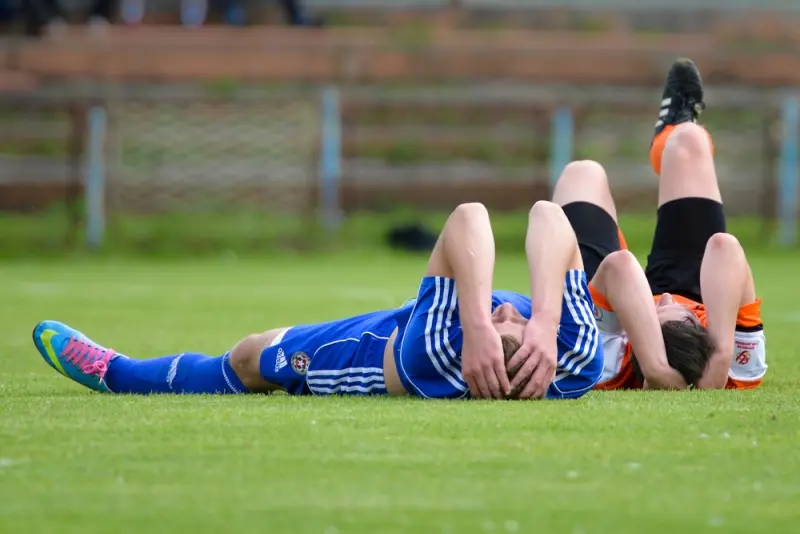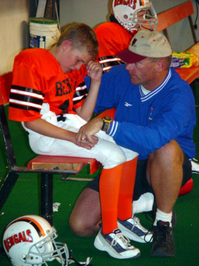
Apr 21, 2017 • 6 min read
When in Doubt, Sit Them Out: Concussion Safety Tips for Parents
Anytime we as parents register our children for any kind of sports activity, there’s always a little voice in the back of our heads warning us of potential dangers. Bumps, bruises and skinned knees are to be expected. Some injuries, though, like concussions, are more serious.
Symptoms of a concussion can be tough to diagnose, recover from and prevent–but in this article we’re going to give you some helpful tips on doing just that!
What Is a Concussion?
 To understand concussion treatment, it’s helpful to know exactly what a concussion is. Believe it or not, our brains aren’t stuck in one place (although, you’d be hard pressed to tell some of your politically-motivated friends that). Our brains move in fluid and, in the event of a head injury, can twist, bounce or move rapidly back and forth in the skull. This can create chemical changes in the brain and stretch and damage the brain cells causing a concussion.
To understand concussion treatment, it’s helpful to know exactly what a concussion is. Believe it or not, our brains aren’t stuck in one place (although, you’d be hard pressed to tell some of your politically-motivated friends that). Our brains move in fluid and, in the event of a head injury, can twist, bounce or move rapidly back and forth in the skull. This can create chemical changes in the brain and stretch and damage the brain cells causing a concussion.
The CDC reports that the amount of reported concussions has doubled in the last ten years and for youth athletes that number continues to trend upward. So even a child who receives a seemingly minor bump or “bell ringing” should immediately get checked out.
The Signs and Symptoms of a Concussion
The signs of a skinned knee or even a twisted ankle are pretty apparent when we see them, so it’s easy to patch a youth athlete up and send them on their way or have them sit out for some time. The signs of a traumatic brain injury (TBI) aren’t as easy to spot, but there are a few key symptoms to look for:
- Lingering dizziness for more than a few minutes
- Blurred vision or trouble focusing
- Lingering headache for more than a few minutes
- Difficulty thinking, concentrating or making decisions
- Difficulty speaking or speaking nonsensically
- Issues with balance and coordination
- Feeling confused, tired, grumpy, upset or emotional for little reason
- The urge to vomit or vomiting
Some of the symptoms of a concussion may not become evident until some hours after the traumatic event, so it’s important to pull a youth athlete from a game after suffering any head injury.
Remember: When in doubt, sit them out.
Likewise, many people do not pass out when they suffer a concussion. If your young athlete does lose consciousness, seek emergency services and call 911 immediately.
Concussion Recovery
Unfortunately, a quick icepack can’t treat a concussion. If the head injury is severe, a doctor will recommend further concussion treatment. But, generally, the only way to recover from a concussion is time and rest.
As a general rule, the young athlete should be removed from all physical activities including all sports, gym class, bike riding and, yes, even riding rollercoasters. This is probably not going to go over well with your young athlete, but the danger here is from Second Impact Syndrome, which can cause severe and permanent brain damage or even death.
But it’s not just physical activity that can further exacerbate the concussion–brain activity can as well. This means anything that can increase brain function too greatly should also be avoided. These activities might include:
- Excessive cell phone use
- Parties or concerts
- Bright lights or strobe lights
- Computer or internet use
- Television
- Video games
- Listening to music through headphones
- Loud or sudden noises
- Working
- Driving
Adhering to all of this might seem excessive, but it’s the only way to assure your young athlete will stay on the road to full recovery.
Concussion Prevention
 When it’s time to return to sports or physical activity, make sure they are introduced slowly and not all at once. Most importantly, make sure you’re taking all the necessary steps to prevent concussions.
When it’s time to return to sports or physical activity, make sure they are introduced slowly and not all at once. Most importantly, make sure you’re taking all the necessary steps to prevent concussions.
- Make sure your young athlete is wearing properly fitting safety gear including helmets, mouth guards, cups, supporters and pads.
- Take care that all playing fields have been properly maintained and don’t have divots or holes that can cause a young athlete to trip or fall.
- See that all parents and coaches are well versed in decoding the signs and symptoms of a concussion or traumatic brain injury.
- Penalize players who make illegal contact, head-to-head strikes or otherwise put themselves and other players at risk for injury.
A large part of concussion prevention and recovery will also come from changing the attitudes of players and coaches. Overall, 7-in-10 youth athletes have reported that they’ve played with concussion symptoms. This often comes from the stigma that sitting out makes a player look “weak” despite the severity of the injury. Coaches, parents and fellow players should encourage and even reward players that report their concussion symptoms and elect to sit out.
Conclusion
Concussions are difficult injuries to deal with–they’re not easy to spot, can be laborious to recover from and prevention can prove to be difficult. Why, then, do we still allow our children to participate in youth sports?
The answer is that there are innumerable benefits that come from competition and participation that are difficult to derive from anywhere else. And as long as we’re always striving to be safer, smarter and more sensitive to the signs and symptoms of concussions, we can work toward reducing them across the board!
